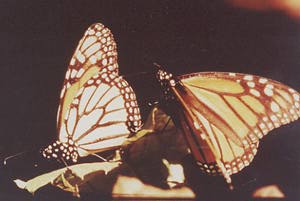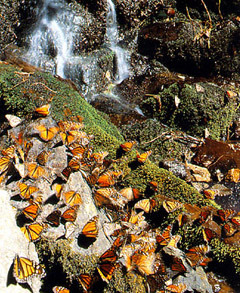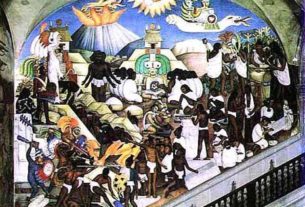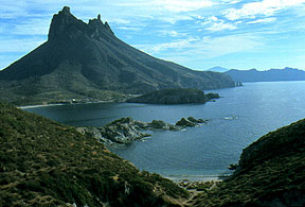Early in 1980, exploring various off the beaten track areas of Mexico looking for potential geography fieldwork sites, one fateful Saturday morning found me standing in the main plaza of the small Michoacán mining town of Angangueo. I was chatting to people and desperately trying to formulate some theory or hypothesis which high school students would enjoy investigating in the immediate environs of the town.
“What is there of interest round here?”, I asked in my broken Spanish.
The inevitable reply was “Nothing!” Most locals explained that, “there are still some mines, an old narrowgauge railway, some spoil tips by the main road, the pine forests… Nothing special! Really!” becoming more interested by the minute, I entered the town hall
and accosted an official. Before I could explain my mission, having first introduced myself as a geographer from England, I was interrupted (in Spanish, of course) by “Oh! You must be from the B.B.C.!”
“B.B.C.?”, I queried hesitantly. “The television and radio company?”
“Yes”, he said, “you must be here to film the mariposas.”
“Mariposas?”, I asked, now more confused than ever. Patiently, as if to a little child, he gestured outside the window. “Those”, he pointed.

I followed his gaze outside but saw nothing except a row of small red-roofed houses, a towering church, people scurrying about the marketplace, a patient few waiting in line for lunchtime buses, and a few orange and black butterflies fluttering about in the sunshine.
The penny dropped! In a flash, I became wide eyed. Mariposas! Butterflies! B.B.C.! Of course, the orange and black Monarch butterflies pictured on a National Geographic cover a few years ago. Millions and millions of them, who came to the same remote corners of the Mexican Sierra Madre year after year, congregating on trees in such huge numbers that the tree branches sometimes broke under their weight. This must be it! This must be that remote corner of the Sierra Madre: Angangueo, the town at the end of the road! Excited, not least because so far as I knew nowhere had their exact location ever been published, I enquired as to the butterflies’ whereabouts.
Later, and having been told that the B.B.C. film crew was not due to arrive for another ten days, I hiked into the mountains in search of the Monarchs. Without a guide it proved hopeless and, unhappily, after several hours of effort, I had to give up and return home.
I was back in Angangueo the next weekend with my Argentinean flat-mate, better prepared and equipped for a long day in the hills. Six hours later, both exhausted, we were again about to give up. Despite magnificent scenery and warm sunshine, our disappointment could scarcely be contained. We had found dozens of dead butterflies on the forest floor but where were those elusive groves of trees with their butterfly covered branches? How could millions and millions of butterflies remain invisible? We decided on ‘one last try’ and set off deeper into the tall stands of fir trees. Rounding a bend in the track came four youths, who explained to us that they were returning from the butterflies but that it would be dark by the time we could reach them, even supposing we didn’t get lost again. Undeterred, we hurried on. Their instructions were exact, though the light was fading with every step.

Suddenly, dramatically, we saw them! Just a few meters from the path was a small clearing in the trees, with dense undergrowth. Everything in sight was cloaked in a mantle of orange and black, moving, swaying and everchanging like a flickering silent movie. A place of infinite peace and extraordinary beauty. As we stared, openmouthed and speechless, the shear magic of the sight overwhelmed us. Countless millions of tiny butterfly bodies were lifted into the air by pairs of colorful wings before they drifted slowly back to earth on the gentle breeze, to settle on anything in their path. Within minutes we were both blanketed by hundreds of Monarchs, unable to move for fear of accidentally squashing them. As fast as we could, lest the light should completely fail, we began to take photos: closeups of single butterflies, shots of branches bowed over by their weight, the orange and black speckled air above our heads, the millions of Monarchs clinging to the tree trunks. We had a fantastic twenty minutes before night finally fell and we were forced to retrace our steps down the mountain, as best we could, in the dark.
Such a marvel as this could not remain a secret for long. Word began to filter out as to where the butterflies overwintered. Mexico City dwellers, anxious for an escape from noise and smog, began to arrive in droves in Angangueo to hunt out the Monarchs for themselves.
Regrettably, but predictably, they brought with them their dubious culture of ghettoblasters, beer cans, picnics, and litter. They also indulged their ‘collecting’ urge by stuffing hundreds of Monarchs into plastic bags as ‘souvenirs’. Some of the local campesinos, quick to spot an opportunity, started to supply small wooden and glass cases with mounted butterflies inside. Needless to say, the losers in all this were the poor, defenseless butterflies.
Fortunately international pressure and growing public awareness resulted in the butterflies’ overwintering zones being declared a federally protected reserve. In most of the dozen or so localities involved in this major annual migration, an event without equal in the butterfly world, only bona fide scientists were allowed access. But one relatively accessible area was converted into a welldisciplined sanctuary, open to the public on payment of a token entrance fee, but subject to strict vigilance and a sensible set of conservation rules. This site, El Rosario, is visited by thousands of people each weekend in the season (December to March) though midweek it is usually virtually deserted.
El Rosario is reached from the small village of Ocampo, midway between Mexico City and Morelia, relatively close to the city of Zitacuaro which has full tourist services. Tourists visiting the El Rosario Reserve during February or March are rarely disappointed. It rarely rains during these months and midday temperatures are warm enough to not need a sweater. A 20-minute walk along wellmade, shaded paths (though the altitude of nearly 10,000 feet may make you feel it’s a lot longer!) and you find the main congregation of Monarchs literally tens of millions of them!
El Rosario’s entrance fee is about US $2 per person and there is ample parking as well as numerous small stalls selling soft drinks and homecooked, and absolutely delectable, “blue corn” tortillas. This is one culinary delight of Mexico not to be missed!
Before taking a Monarch tour, check carefully that the tour will be accompanied by a knowledgeable naturalist (it makes it so much more interesting), and ask to speak with people who have been on the tour before not all of the many companies now offering trips to see the butterflies can be recommended.
For a fuller account of the Monarchs, read chapter 29 of Tony Burton’s book “Western Mexico, A Traveller’s Treasury” (3rd edition, Perception Press, 2001).
To learn more about the Monarch Butterfly, Visit Monarch Watch.



